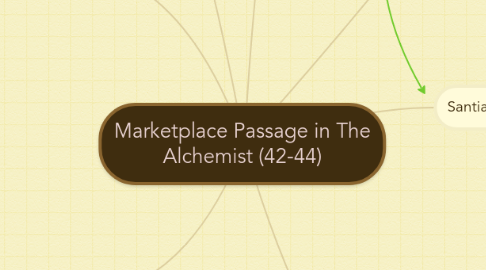
1. Santiago's Present Setting
1.1. Tangier
1.1.1. New World: "Looking around, he sought his sheep, and then realized that he was in a new world."
1.1.2. Marketplace: "He walked slowly through the market."
1.1.3. Shepherd boy is far away from Andalusia, Spain
2. At this point in the narrative Santiago is in a foreign land, Tunisia, far away from the sheep and family of his more familiar Spanish surroundings. When he becomes aware of his new surroundings he feels he's discovered something new in the world. A new day has dawned!
3. Characters Santiago Meets or Recalls
3.1. Candy seller
3.1.1. Old King
3.1.1.1. His smile reminded the boy of the old man- the mysterious old king he met.
3.1.2. Different types of personal legend.
3.1.2.1. This candy merchant isn't making candy so that later he can travel or marry a shopkeepers daughter. He's doing it because it's what he wants to do.
3.1.2.2. Santiago's personal legend is to find a hidden treasure. This is considerably different from just selling candy.
3.1.3. Shopkeeper's Daughter was his first "love".
4. Santiago's Interaction with Candy Seller
4.1. Idea 1
4.1.1. He has his Personal Legend
4.2. Idea 2
4.2.1. The wisdom of the Old King comes to mind
4.3. Idea 3
4.3.1. Santiago perceives his own ability to detect Personal Legend in others
4.4. Idea 4
4.4.1. The generosity of candy seller emphasizes idea that money or possessions don't equal personal happiness
4.5. Idea 5
4.5.1. The shepherd sees there exists a mostly unspoken bond between them
5. Narrative Viewpoint: first person, third person, limited omniscient, objective
5.1. First Person: Santiago is at a low point but finds himself ready to take on his adventure to find his Personal Legend
5.2. Third Person: We see Santiago getting up from sleeping on the ground, as he helps a candy seller , getting a treat in return
5.3. Limited Omniscient: We can tell that Santiago was feeling disheartened about his Personal Legend, but how he then felt ready, helping anyone possible
5.4. Objective: Santiago had woken up, helped out a candy seller, and got a reward from it
6. Figurative Language: Metaphors, Similes, Imagery
6.1. Metaphor
6.2. Simile
6.3. Imagery
7. Syntax: Sentence Type: Simple, Compound, Complex, Compound-Complex
7.1. Simple
7.2. Compound
7.3. Complex
7.4. Compound-Complex
8. Story Ideas (Themes) suggested by Journey to this point: 1.Santiago is on a quest in which he encounters and overcomes obstacles in pursuit of his Personal Legend, his biggest obstacles thus far being the absence of his own familiar environment and life in a new part of the world where language and customs are strange to him 2. Santiago sees his stay at the marketplace in Tangiers as a new beginning 3. The hero even envisages the ideal of a language that transcends time/place. He says "If I can learn to understand this language without words, I can learn to understand the world". He's beginning to see that the Old King is right: "All things are One."
9. Santiago's Plan
9.1. Goals
9.1.1. Search for Treasure: physical
9.1.2. Search for Personal Legend: spiritual
9.1.2.1. Identification of Personal Legend with candy seller
9.1.2.1.1. Personal Legend here means personal contentment with one's lot in life
9.2. Perceived problem 1: "He had not a cent in his pocket..."
9.2.1. Perceived problem 2: "There must be a language that doesn't depend on words..."
9.3. Resolution of perceived problems
9.3.1. There is comfort in the Old King's words that "All things are one"
10. Santiago's Discovery
10.1. Insight 1: World is a magical place
10.1.1. "Magical Realism" as a literary technique (Marquez)

